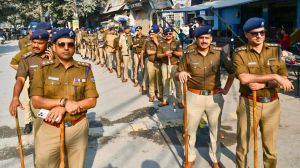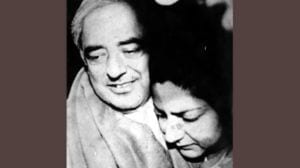J&K results: Will take time in exploring possibilities, says PDP Chief Mehbooba Mufti
"We are not in a hurry to cobble up numbers. Will explore possibilities to give a credible govt," said Mehbooba.
WITH the election results on Tuesday throwing up a fractured mandate in Jammu and Kashmir — the Peoples Democratic Party (PDP) emerged as the single largest party with 28 seats, followed by the BJP with 25 — it may be time for some new political alignment in the state.
The verdict has thrown open several possibilities, but it is not just the mathematics that will decide the coalition partners in the government. Even as all the parties claimed that they were keeping all options open, the party positions and poll promises are also likely to come into play.
The PDP has won 28 seats, seven more than its 2008 tally, but still well below the party’s expectations. The BJP has come a close second with 25 seats — a surge of 14 seats from its last tally. The National Conference is down to 15 — its lowest in several decades — while the Congress has won 12 seats.
In order to form the government, the PDP will have to cobble up a coalition with 44 seats — the halfway mark in the 87-seat assembly. Despite many possibilities, choosing a coalition partner will be a difficult decision, given their positions during the campaigning. “It is a messy verdict,” said Chief Minister Omar Abdullah. “I am glad that Mufti is in more of a mess than me.”
The BJP may have fallen short of its “Mission-44”, but it has emerged as a major player in the state for the first time, sweeping the Jammu region from where it won its 25 seats. But with the three other players — PDP, NC and Congress — indicating that they want to keep the BJP away, the party’s dream of forming the government may remain unfulfilled.
“If we do not form the government, the voters in Jammu region from where the BJP won all its seats (25 of 37) would feel that their votes were wasted,” said a senior Union minister. “A BJP-PDP alliance will be mutually destructive. Such an alliance will destroy our ideological positions,” he added, referring to the BJP’s interests in the Jammu region and PDP’s in the Valley. The BJP’s parliamentary board is set to meet in New Delhi on Wednesday for discussions.
Mathematically, a PDP-BJP coalition is the easiest possible way out. The two parties together have 53 seats. However, this would not be an easy decision for both the parties. The BJP’s campaign targeted dynastic politics in the state, with both Prime Minister Narendra Modi and party president Amit Shah seeking to dislodge the Abdullahs and Muftis from the power. So it would be difficult for the BJP to support a dynastic chief minister.
It would also be difficult for the BJP to align with the PDP, given their positions on the Kashmir issue. While the BJP wants the state’s complete integration with the union of India and abrogation of Article 370, the PDP has been advocating self-rule with joint control of the state by India and Pakistan and dual currency.
Also, playing the role of a junior ally would be a difficult task for the BJP, especially in J&K.
The PDP, on the other hand, has been critical of the BJP for dividing the state on “communal lines” during the elections. Moreover, the party won 25 of its 28 seats from the Valley, where the voters have rejected the BJP.
The most likely combination seems to be a PDP-Congress alliance. But the two parties together account for only 40 seats, and would need support from Independents. The Congress is ready for an alliance. “We are open to a secular alliance,” said state Congress president Saifuddin Soz. “We will wait and see how it comes up”.
A PDP-Congress coalition government, however, would mean that the Hindu majority in Jammu region would not be represented, as the Congress’s five seats from Jammu have been won from the Muslim-majority Chenab and Pirpanjal regions.
The most unlikely scenario seems to be a PDP-NC coalition, although Omar Abdullah didn’t rule out the possibility. “I am not going up the road,” he said. “(But) if Mufti sahib picks up the phone, there is a crack open (for alliance with PDP)”. His comments are being seen by BJP leaders as a sign of his eagerness to keep the BJP out of power in the state.
A coalition government without the PDP as a partner is also possible if the NC joins hands with the BJP. Though Omar said such an alliance was “most unlikely”, the two parties have a previous association. The BJP’s problems with an alliance with NC, however, would again be its strong stand against dynastic politics, especially the Abdullahs.
Meanwhile, all the parties have kept their options open. “We would not like to cobble up a government with break and make of numbers,” said PDP president Mehbooba Mufti. “We will sit together and decide. I assure you, it would be a government that will keep the aspirations of the people in mind. It will take some time”.
In New Delhi, BJP chief Amit Shah said his party was keeping all options open. BJP leaders said they would hold talks with leaders from both the PDP and NC.
PDP chief spokesperson Naeem Akhtar was more candid about the difficulties the party faces in taking a decision. “As of now, we are not blocking anyone,” he said. “It is a Catch-22 situation for us. We have ideological differences with the BJP and the vote is against the Congress”.
The fractured verdict has also put the focus on the three independent candidates — Engineer Rashid, Pawan Gupta and Syed Mohammad Baqir — and the single-seat parties of J&K Peoples Democratic Front, CPI(M), and Sajad Lone’s Peoples Conference which has won two seats. “To be very frank, I am not dying to be part of any government,” said Lone. “But if some kind of formation comes up, we will take a decision. We would sit and decide which way to go”.




- 01
- 02
- 03
- 04
- 05



























